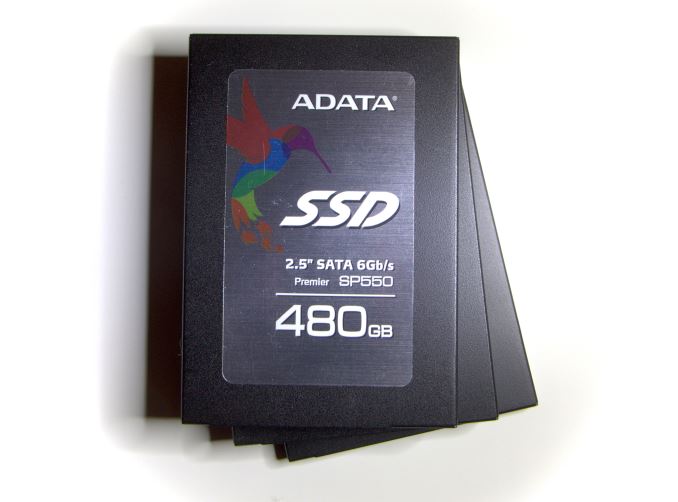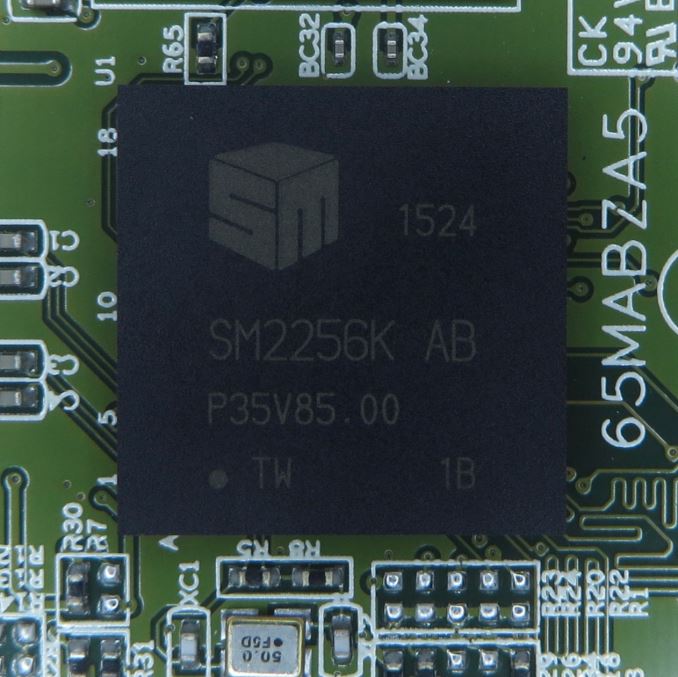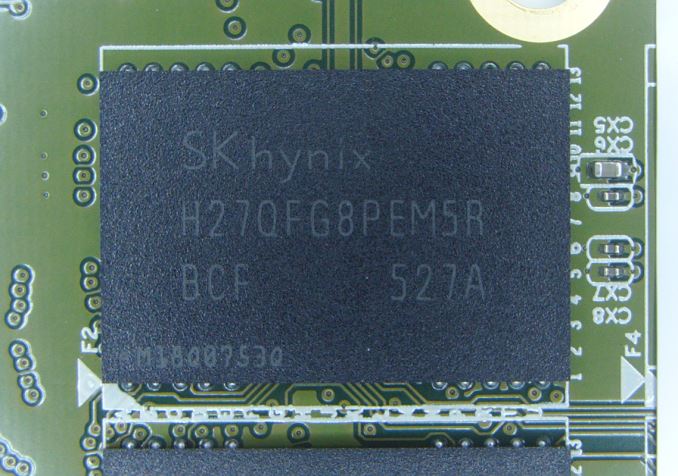The ADATA Premier SP550 SSD Review: A Second Look At Silicon Motion's SM2256 Controller
by Billy Tallis on March 23, 2016 8:30 AM EST
Silicon Motion's SM2246EN SSD controller was a highly successful solution for SSDs using MLC NAND flash. It offered a great combination of power efficiency, solid performance, and low cost. Last year we got an early look at the successor SM2256 controller for drives using TLC NAND and found that despite being made for TLC it didn't do a very good job of mitigating the performance and power consumption problems inherent to TLC NAND. At the time there were only a few mainstream TLC drives and the SM2256 was one of the first controllers designed specifically with TLC in mind. That preview was based on a reference design drive using Samsung 19nm TLC and prerelease firmware, so we were hopeful for improvement in final retail products that would be using different NAND and firmware.
In November we looked at the performance of the Crucial BX200 based on the SM2256 controller and Micron 16nm TLC NAND, and we found that the situation had gotten much worse: performance was bad and power consumption was high. In the meantime, Phison's S10 controller (and Toshiba's custom branded variant of it) became the most popular solution for TLC SSDs and the market was flooded with nearly-identical drives from new and old players in the market.
That brings us to today's review of ADATA's Premier SP550 SSD. ADATA manufactures drives with almost every controller available on the open market, and the Premier SP550 is their SM2256 offering. ADATA has in turn positioned the drive as the entry-level model of their mainstream consumer Premier product line. Meanwhile with a different choice of flash (SK Hynix 16nm TLC NAND) and updated firmware, the SP550 has the chance to partially redeem the SM2256 controller.
| ADATA Premier SP550 Specifications | ||||
| Capacity | 120GB | 240GB | 480GB | 960GB |
| Controller | Silicon Motion SM2256 | |||
| NAND Flash | SK Hynix 16nm TLC | |||
| Sequential Read | 560MB/s | 560MB/s | 560MB/s | 520MB/s |
| Sequential Write | 410MB/s | 510MB/s | 510MB/s | 490MB/s |
| Random Read IOPS | 60k | 75k | 75k | 80k |
| Random Write IOPS | 70k | 75k | 75k | 35k |
| TCG Opal Encryption | No | |||
| Power Management | Slumber and DevSleep | |||
| Warranty | 3 years | |||
| Current Retail Price | $38.99 | $57.99 | $112.99 | $219.99 |
With pricing starting at $39 for 120GB and even the 480GB model staying under $0.25/GB, the pricing is a good start, as the SP550 has consistently been one of the cheapest drives on the market. No TLC drive has yet reached a price low enough to completely excuse its shortcomings relative to MLC drives and earn an unconditional recommendation, but at least the SP550 has kept pace with the price drops in recent months. Its primary competitors are Phison/Toshiba-based SSDs with Toshiba's A19nm TLC, as their successors based on Toshiba's 15nm TLC are still new enough to the market to be selling for higher prices closer to the MSRP. This means we'll be looking at the OCZ Trion 100 as the most likely alternative, though similar drives from Silicon Power and PNY are available in the same price range and newer drives like the OCZ Trion 150 may match its price it in the near future.
| AnandTech 2015 SSD Test System | |
| CPU | Intel Core i7-4770K running at 3.5GHz (Turbo & EIST enabled, C-states disabled) |
| Motherboard | ASUS Z97 Deluxe (BIOS 2501) |
| Chipset | Intel Z97 |
| Memory | Corsair Vengeance DDR3-1866 2x8GB (9-10-9-27 2T) |
| Graphics | Intel HD Graphics 4600 |
| Desktop Resolution | 1920 x 1200 |
| OS | Windows 8.1 x64 |
- Thanks to Intel for the Core i7-4770K CPU
- Thanks to ASUS for the Z97 Deluxe motherboard
- Thanks to Corsair for the Vengeance 16GB DDR3-1866 DRAM kit, RM750 power supply, Carbide 200R case, and Hydro H60 CPU cooler












25 Comments
View All Comments
tipoo - Wednesday, March 23, 2016 - link
I never really thought about core counts in storage controllers before this review. What would your average mid range and high end SSDs have for controller CPUs?I think I also remember looking into this model for a cheap old laptop upgrade, but some reviews mentioned it didn't have a DRAM cache which made performance consistency very not consistent. That looks similar here in the charts, is this the one with no DRAM?
vladx - Wednesday, March 23, 2016 - link
Most SSD controllers use dual or tri-core ARM Cortex-R4 configurations.MrCommunistGen - Wednesday, March 23, 2016 - link
The 2TB 850Pro/EVO article here on Anandtech has a table showing core counts and clock speeds of the recent Samsung SSD controllers: MDX, MEX, MGX, MHX, all of which are 3-core ARM Cortex R4 except for the MGX which is a dual core ARM Cortex R4.The breakdown is a bit complex but it looks like MDX is 840/840 Pro. MEX is 840 EVO, 128-1TB 850 Pro, and 1TB 850 EVO. MGX is 120-500GB 850 EVO, and MHX is in the 2TB 850 Pro/EVO.
Going through historical articles (840 Pro review) I found that the Samsung 830's controller was called the MCX and it is implied but not directly stated that it was a 3-core ARM9 design.
Not to toot my own horn, but the "Update" in the 840 Pro article regarding MDX being R4 rather than ARM9 was at least partially due to an email chain I had with Anand. Yes, I emailed him instead of blasting him in the comments section. As I recall, he said the original press kit had said ARM9. I'd seen Cortex-R4 elsewhere on the 'net, and Anand reached out to Samsung for confirmation. I assume he got it because he updated the article later that day.
I don't remember seeing much info on core counts for other controllers, but the 840 Pro article also has a table where it notes DRAM Size for various controllers of the time. What's notable to me is that the old Intel controllers like in the X25M G2 didn't cache user data, only the mapping tables, so the G3 is listed in the table as using up to 64MB cache.
Also notable is that the SandForce controllers didn't use a DRAM cache - probably a large part of their huge industry success, in addition to their (at the time) class leading performance, and the fact that they sold turn-key solutions to OEMs.
Billy Tallis - Wednesday, March 23, 2016 - link
The SP550 uses Samsung DRAM. Silicon Motion does have a controller designed for DRAM-less MLC drives, but their controllers for TLC SSDs all still have a DRAM controller. I've been told that it's theoretically possible to use SM2256 or SM2258 without external DRAM, but I don't know if anyone has actually written the firmware necessary to accomplish that. The performance hit of operating without external DRAM is so far something that is usually only acceptable for USB drives, not mass-market SATA SSDs.hojnikb - Wednesday, March 23, 2016 - link
Well, sandforce and sm246xt perform just fine without dramghanz - Wednesday, March 23, 2016 - link
In general, they perform fine for light & general user scenarios, but IOPS suffers.In SM2246XT product brief, random reads are quoted at 28,000 IOPS & random Write at 65,000 IOPS (120GB SSD with Toshiba 19nm MLC).
Both Sandforce & SM2246XT are only used with MLC NAND since they were not design to work with TLC ones.
The IOPS drop on a theoretical SSD controller without external dram & working with TLC NAND will be much worse I presume.
Samus - Wednesday, March 30, 2016 - link
Any TLC platform without DRAM or an SLC caching mechanism is going to burn out the NAND; the wear leveling will be off the wall.Pizzahut23 - Wednesday, March 23, 2016 - link
Are we going to get a review of the phison PNY cs2211? It was recommend last month on the recommend budget SSD list. How does it compare to the legendary bx100 which is about the same price? Is it the new go to budget SSD?Billy Tallis - Wednesday, March 23, 2016 - link
I've tested both the PNY CS1311 and CS2211. They won't be the next review I post, but probably the one after that. As compared to the BX100, the CS2211 is very broadly in the same performance class, but its different controller architecture means it has very different strengths and weaknesses.ghanz - Wednesday, March 23, 2016 - link
Hi Billy, are there any plans to review the Sandisk Plus 240gb or/& 480gb?It's probably cheapest MLC drive in lower capacities now I believe.
While it's similar to the Sandisk extreme 500, it will be interesting to see the differences of the same SM2246XT controller on a SATA3 interface instead of USB 3.0/3.1.
It will also be interesting to compare a budget MLC drive with the influx of recent budget TLC drives.